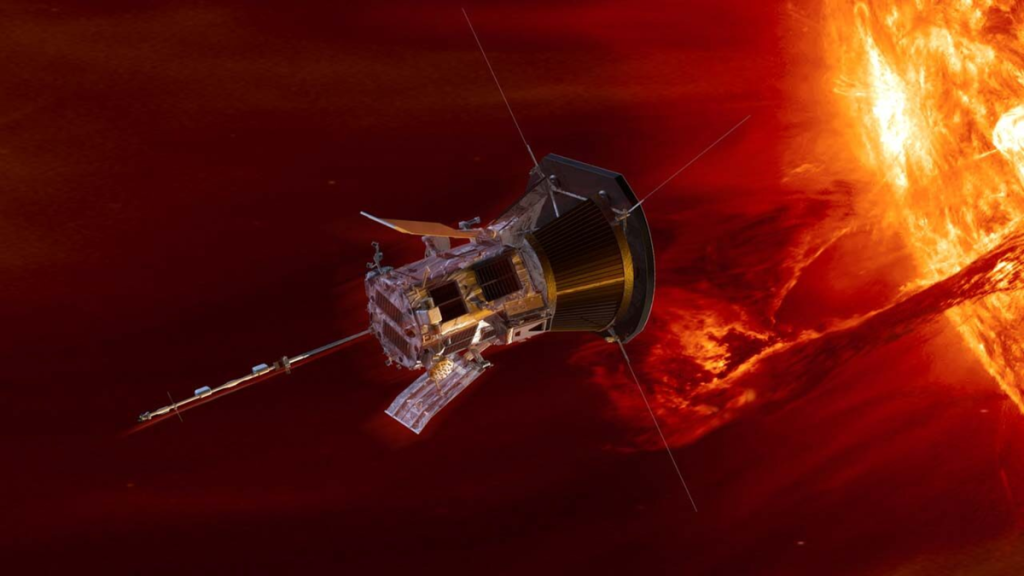
‘We are preparing to make history’: NASA’s Parker Solar Probe gears up for epic sun flyby on Christmas Eve (Image Credit: Space.com)
On Christmas Eve, NASA’s Parker Solar Probe will swoop within 3.8 million miles (6.1 million kilometers) of the sun’s surface at a whopping 430,000 mph (690,000 kph), breaking its own records for speed and closest approach to our star.
The spacecraft, roughly the size of a small car, completed its final swing past Venus last month, setting it on a path to come closer to the sun than any human-made object ever has before.
On Dec. 24, the Parker Solar Probe is expected to cut through plumes of plasma that are still rooted to the sun and even fly through a patch of a solar eruption, akin to a surfer diving under a crashing wave. In October, the sun reached its most turbulent phase in its 11-year cycle, meaning the spacecraft will soon get to study powerful solar flares occurring on top of each other, providing scientists with up-close data about the chaotic workings of our star.
“We are preparing to make history,” Nour Rawafi, who is the project scientist for the mission, told reporters at the Annual Meeting of the American Geophysical Union (AGU) on Tuesday (Dec. 10). “Parker Solar Probe is opening our eyes to a new reality about our star,” he said, adding the data sent home by the probe “is going to take us decades to sort through.”
Related: Parker Solar Probe: First spacecraft to ‘touch’ the sun
The probe’s Christmas Eve feat is expected to occur at 6:40 a.m. EDT (1140 GMT), but mission control will be out of contact with the spacecraft at this time. Shortly before and after the closest approach — on Dec. 21 and Dec. 27 — scientists will look for a beacon tone from the probe that will confirm its health. If all goes to plan, the first images following the encounter may come as soon as the New Year kicks in, with science data following in the weeks after, said Rawafi.
Since its launch in 2018, the probe has helped decode longstanding mysteries about our star, chief among them being how its tenuous outer atmosphere, the corona, gets hundreds of times hotter the farther it stretches from the sun’s surface. In 2022, a chance alignment of the probe with Europe’s Solar Orbiter spacecraft provided scientists the rare opportunity to study the same patch of solar wind, revealing how energy-packed plasma waves accelerate the solar wind to its unexpectedly high speeds.
Among its other discoveries, the Parker Solar Probe has also provided the first compelling evidence for the long-theorized but elusive dust-free zone around the sun, which is created by sunlight heating cosmic dust to high temperatures and turning it into gas.
A key reason for the spacecraft’s good health for six long years and counting is the mission team’s remarkable engineering, including a custom heat shield and an autonomous system that protects the probe from the sun’s wrath even while pointing it toward our star to allow the coronal material to touch the spacecraft.
During its upcoming closest approach to the sun, the front of the heat shield is expected to reach a sizzling 1,800 degrees Fahrenheit (982 degrees Celsius). That’s pretty hot, but the mission team is confident the spacecraft and its instruments can handle temperatures up to 2,500 degrees F (1,371 degrees C).
“It’s really great to see all the science that is enabled by the fact that we overprepared,” said Elizabeth Congdon, who is the lead engineer for the probe’s thermal protection system. A specially designed white coating will reflect much of it back into space such that the spacecraft itself will witness relatively comfortable room temperatures, she added.





